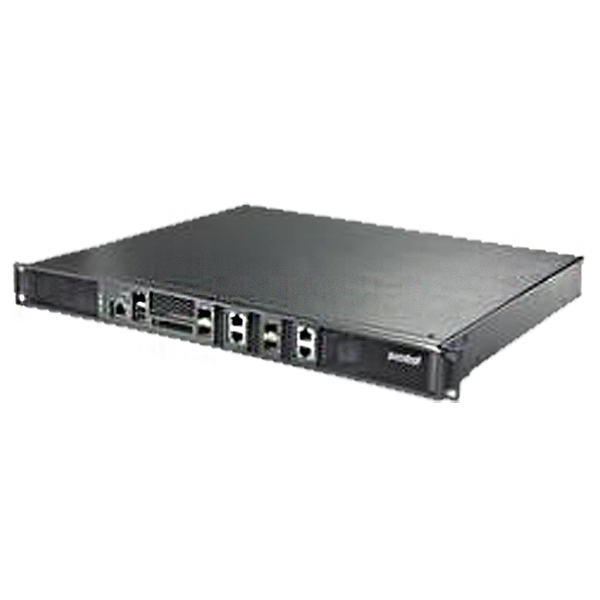Zebra RFS7000 Wireless Switch
The RFS 7000 wireless switch delivers unmatched performance, security, resiliency, scalability and manageability for the large wireless enterprise/campus/warehouse, providing a single platform capable of delivering carrier-grade wireless voice and data for 8,000-96,000 users. Motorola’s Wireless Next Generation (Wi-NG) architecture improves operational efficiency of a wireless switch and reduces the cost of mobility with a powerful comprehensive feature set that includes Adaptive AP, SMART RF and Wired/Wireless Firewall for Wi-Fi, RFID locationing, providing gap-free layered security, and unmatched reliability for 802.11n with Mesh, centralized management and more – best ROI and lowest TCO.
-
Role-based wired/wireless firewall
The RFS 7000 wireless RF switch comprehensively secures and protects the wired and wireless network with Stateful Inspection against attacks and unauthorized access at Layer 2 and Layer 3; ability to create identity and location-based policies provides granular control of network access. -
Adaptive AP support
Supports 1024 AP-5131 802.11 a/b/g or AP-7131 802.11 a/b/g/n Adaptive Access Points per Switch and 12,288 per cluster. Multiple country configuration support for Adaptive AP -
Adaptive AP — Extending the Enterprise
Enables centralized management of 802.11 a/b/g/n mesh access points at remote sites including automatic firmware upgrades; provides site survivability for remote locations with 802.11a/b/g/n networks for unparalleled resiliency. -
Clustering and failover features
RFS 7000 Wireless RF switch supports multiple levels of redundancy and failover capabilities to ensure high availability networks; provides a single Virtual IP (per VLAN) for the cluster for use as a default gateway by mobile devices or wired infrastructure; built-in DHCP/ AAA server synchronized failover; multi-platform license sharing enables deployment of cost-effective networks. -
Comprehensive layered security
Exceptional level of data and network protection without sacrificing fast roaming, including: WPA2-CCMP (with 802.11i fast roaming options); Stateful Firewall at Layer 2 and Layer 3 for the wired and wireless network with role based configurations; Geofencing, integrated RADIUS Server; IPSec VPN Gateway; Secure Guest Access Provisioning; 802.11w for management frame protection, and 24×7 dedicated security via Motorola’s Wireless IPS, providing the advanced technology required to detect any rogue network, including 802.11n -
Enhanced End-to-End Quality of Service (QoS)
Enhances voice and video capabilities; prioritizes network traffic to minimize latency and provide optimal quality of experience; SIP Call Admission Control and Wi-Fi Multimedia Extensions (WMM-Power Save) with Admission Control enhances multimedia application support and improves battery life and capacity; network optimization through granular bandwidth contracts based on bandwidth utilization network load and number of users for different applications being used, in different locations; TSPEC Admission Control ensures ample bandwidth and a superior user experience for VoIP calls; 802.11k provides effective radio resource management. -
Real Time Locationing System (RTLS)
The RFS 7000 Wireless switch provides rich locationing services to enable real-time enterprise asset-tracking through support for 802.11, RFID and third party locationing solutions — including industry leaders AeroScout, Ekahau, and Newbury Networks. Standards-based support for: EPC Global ALE interface for processing and filtering data from all active and passive tags; and EPC Global LLRP interface for passive RFID tag support. -
SMART RF Management
Next generation self-healing: enables the WLAN to automatically and intelligently adapt to changes in the RF environment to eliminate unforeseen gaps in coverage. -
True mobility
Virtual AP provides better control of broadcast traffic and enables multiple mobile and wireless applications with quality of service when network is congested; Pre-emptive Roaming ensures Motorola mobile devices roam before signal quality degrades; Power Save Protocol optimizes battery life. -
Wi-NG architecture — delivering a unified voice, data and RF management platform
Improve business process flow with one platform for wireless voice, video, data and multiple RF technologies on one platform — such as RFID, Wi-Fi (including 802.11n) and future technologies such as Wi-MAX; rich enterprise-class functionality includes seamless roaming across L2/L3 deployments, resilient failover capabilities, comprehensive security, toll-quality voice and other value-added services, such as multi-RF locationing. -
Wireless Intrusion Protection System
The wireless switch contains a built-in wireless intrusion protection system provides defense against over-the-air attacks by leveraging the sensing capabilities of AP300/ AP51x1/ AP7131
Physical Characteristics
Dimensions (HxWxD)
44.45mm x 440mm x 390.8mm
Form factor
Standard 1RU
MTBF
≥65, 000 Hours
Part numbers
RFS-7010-100R0-WR: Zero Port Wireless Switch; RFS-7010-10010-WR: 128 Port Wireless Switch; RFS-7010-10020-WR: 256 Port Wireless Switch; RFS-7010-10030-WR: 64 Port Wireless Switch; RFS-7010-UC-16-WR: 16 Port Upgrade License certificate
Physical interfaces
4 X 10/100/1000 Cu/SFP Ethernet interfaces, 1 X 10/100 OOB port, 1 X CF card slot, 2 X USBslots, 1 X serial port (RJ45 style)
Weight
13.5lbs / 6.12kg
Power Characteristics
AC input voltage
90 – 264 VAC 50/60Hz
Input frequency
47 Hz to 63 Hz
Max AC input current
6A@115 VAC, 3A@230 VAC
Regulatory Specifications
Electrical safety
UL 60950-1, C22.2 No. 60950-1, EN 60950-1, IEC 60950-1
EMC
EN 301 489-1, EN 301 489-17, IEC 60601-1-2, EN 55022, FCC Part 15 Class B, ICES 003 Class B, EN 55024, EN 61000-3-2, EN 61000-3-3
Environmental
RoHS Directive 2002/95/EEC
User Environment
Operating humidity
5% to 85% (w/o condensation)
Operating temperature
0º C to 40º C
Storage humidity
5% to 85% (w/o condensation)
Storage temperature
-40º C to 70º C

